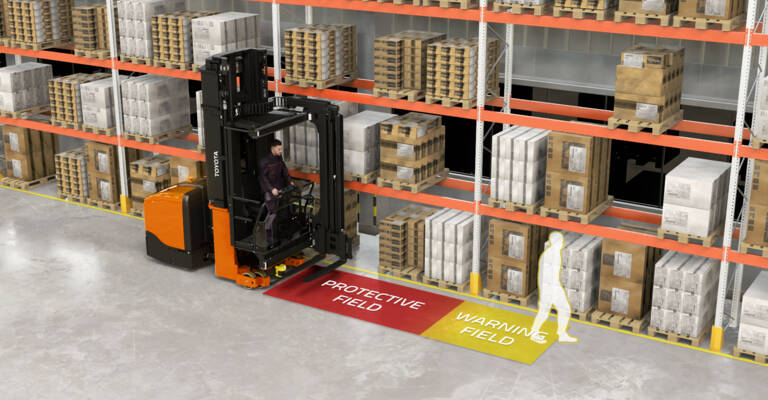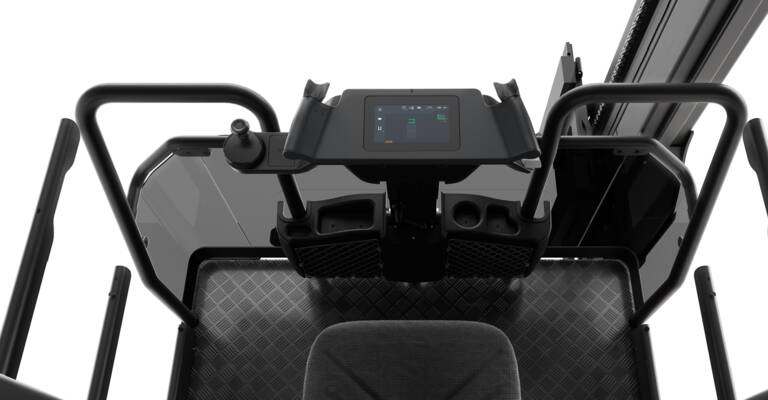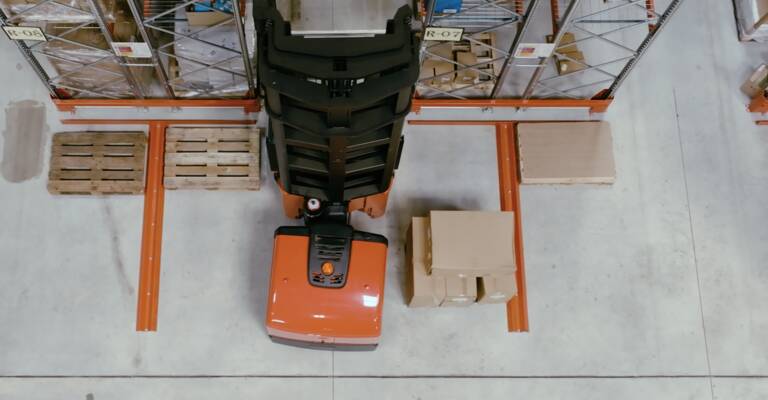VNA
VNA (very narrow aisle) trucks are designed specifically for replenishment and order picking in high-density warehouses and distribution areas. High density means more can be stored simply by narrowing the aisle width, helping to maximise storage space. Most models of the Toyota VNA range come with an articulated chassis, making this series, with its excellent stability and manoeuvrability, perfect for work in very narrow aisles. The range has load capacities between 1000 kg and 1500 kg and runs with both rail and wire guidance.
How to make demanding work in narrow aisles easier
Driving in narrow aisles and lifting to elevated heights is not an easy job. Operators need to be properly trained when working in these demanding applications. Luckily, they can count on a range of tools and features to support them throughout their shift.

Creating a safer workplace with PPS (Personal Protection System)
The Personal Protection System (PPS) is a feature that enables the Toyota BT Vector VNA truck to slow down before coming to a complete stop when it finds obstructions on its path, taking over from the driver. PPS consists of two safety scanners, one in the front and one at the rear of the truck.
Especially when working at high altitude, the driver has limited visibility on the ground below. The scanner in front of the truck creates 2 zones, a warning zone and a stop zone, to help the driver avoid possible collisions in the aisle.

A well laid out driver compartment provides comfort and safety
Driver ergonomics is a priority. Operators spend many hours per day in these trucks. Ergonomic seat design and intuitive controls with colour touchscreen make operating Toyota's VNA trucks highly comfortable.
Integrated pre-op check and smart access allow for an easy and safe start-up. Situation-based information is collected to boost productivity and guarantee safe operation.
The compact driver compartment allows operators to hop on and off the truck easily, and lets them work upright if they desire, increasing their productivity.
Saving energy with Toyota's Advanced Lifting System
The energy required to lift the cabin and load on the BT Vector range is reduced up to 35% by Toyota’s Advanced Lifting System (ALS). A balanced lift system where the gas tank is connected to a hydraulic cylinder forms a fully closed loop system. Precise electronic control guarantees seamless and smooth operation.
Energy converted into nitrogen is compressed while lowering the cab, building up gas pressure. The energy stored as compressed gas is then used to aid the next lifting movement. As a result, the hydraulic lift motor is working to lift little more than the weight of the load itself, saving energy. Fork carriage and mast are lifted thanks to the expansion of nitrogen gas.
How Toyota's VNA trucks move smoothly in narrow aisles
Navigation
Thanks to pallet location programming, Toyota's VNA trucks calculate the optimal route from point A to B and take the most effective route. The BT Vector adapts its driving speed by going faster at a lower lift height and slower at an elevated lift height. This results in leaner operations, reduced cycle times, and significantly improved productivity.
Aisle indication
The VNA trucks from Toyota adjust the travel speed thanks to aisle indication tags. At both ends of the aisle, where in-aisles control is extra important, the truck safely decelerates, while going at maximum speed along the middle of the aisle. This is thanks to the aisle indications AEB (Aisle End Braking) and AES (Aisle End Stop).
Zoning
The Toyota BT Vector VNA range prioritises safety, by adapting to different local building constraints like roof beams and ventilation shafts. This is done thanks to the zoning function: sensors on the VNA truck communicate with RFID tags spread across the aisle.
Read about the benefits of VNA racking for Adveo
Adveo and Toyota storage solution

Flexibility and high throughput are the wins Adveo take from Toyota’s storage solution
Adveo is one of the main European players in the wholesale distribution of office supplies, services and solutions. They wanted a partner that could support in their project from start to finish. Romain Thénard, Supply Chain Director at Adveo, admits: “Our job is to prepare orders, not to define all the technical elements in site building. We lack the engineering capabilities to do so.”
Toyota was able to help in the design, the definition, the implementation, the execution and even in the financing.
